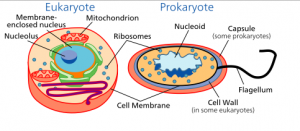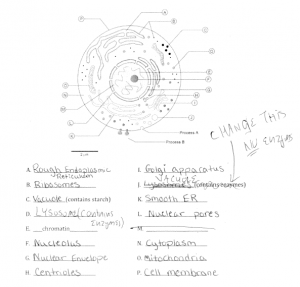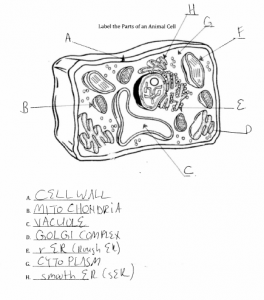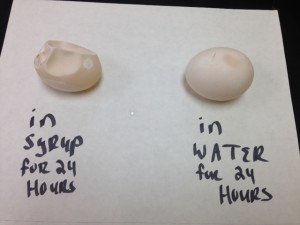7.1 Life is Cellular pages 190-194
- Objectives:
- What is the Cell Theory?
- Who are the contributors to the cell theory?
- How are prokaryotic and eukaryotic cells different?
The Cell Theory states
- All living organisms are composed of cells
- Cells are the basic unit of structure and function
- All cells come from pre-existing cells
Contributors to the Cell Theory
The cell theory was not developed by one scientist but instead came from contributions of several scientists.
- Van Leeuwenhoek is credited with inventing the microscope. Without a microscope, scientists could not observe the tiny cells.
- In 1655, Englishman Robert Hooke examined a cork under a microscope noting tiny chambers. He called the chambers “cells” because they reminded him of rooms in a monastery.
- In 1838, German botanist Matthias Schleiden concluded that all plants came from cells
- In 1839 another German scientist, Theodor Schwann discovered that all animals were composed of cells
- The physician Rudolf Virchow concluded that cells can only be produced from other cells.
How are prokaryotic cells and eukaryotic cells different?
Prokaryotic cells are typically smaller and simpler than eukaryotic cells. The most significant difference is that prokaryotic cells do NOT have a nucleus. Their genetic material is free in the cytoplasm.
Eukaryotic cells are larger and more complex. They contain many smaller structures called organelles which serve a variety of functions for the cell and can specialize the cell for a specific purpose. Example, salivary cells contain many organelles that secrete materials. The most significant feature of a eukaryotic cell is its nucleus which contains the cell’s genetic material.
Both types of cells have a cell membrane and have DNA at some point in their lives.
Review link:
Crash Course Biology
Animal Cells:
http://www.youtube.com/watch?v=cj8dDTHGJBY&list=PL3EED4C1D684D3ADF&index=4
Ch 7.2 Cell Structure
Objectives:
- What is the role of the cell nucleus?
- What are the functions of the vacuoles, lysosomes, and the cytoskeleton?
- What organelles help and transport proteins?
- What are the functions of the chloroplast and mitochondria?
- What is the function of the cell membrane?
What is the role of the cell nucleus?
The nucleus contains nearly all the cell’s DNA. DNA provides instructions for replicating the cell, making proteins, and other important molecules.
The genetic information is stored in the cell’s chromosomes. Because the organelles that make proteins are outside the nucleus and the instructions to make the proteins are inside the nucleus, the nucleus is surrounded by a nuclear membrane that is covered with nuclear pores. The pores allow the coded genetic material to leave when needed.
What are the functions of the vacuoles, lysosomes, and the cytoskeleton?
What organelles help and transport proteins?
Ribosomes are small particles of RNA found in the cytoplasm and are the site of protein assembly.
“Free” ribosomes are found in the cytoplasm where they make materials that will stay in the cell
Some ribosomes are attached to the endoplasmic reticulum. These are ribosomes make materials that will be exported from the cell
Endoplasmic reticulum (ER) is found in eukaryotic cells. It assembles parts of the lipid bi-layer as well as proteins and other materials to be exported from the cell.
If ER has ribosomes attached, it is called rough ER (rER).
If no ribosomes are attached, it is called smooth ER (sER)
What are the functions of the chloroplast and mitochondria?
What is the function of the cell membrane?
Ch 7.3 Cell Transport
Vocabulary:
diffusion
facilitated diffusion
aquaporin
osmosis
isotonic
hypertonic
hypotonic
Class demonstration: Osmosis the egg lab
Examine an egg that has been soaked in vinegar for 48 hours. The hard shell has been removed but the cell membrane remains. The egg feels “squishy”
Weigh the egg. The mass is 72.50 grams
- Place the egg in a cup of syrup over night.
- How has the shape of the egg changed?
- Reweigh the egg. The weigh after soaking in syrup is 62.50 grams
- Place the egg in a cup of water over night.
- How has the shape of the egg changed?
- Reweigh the egg. The weigh after soaking in syrup is 92.50 grams
Conclusion:
- What is moving in and out of the egg (cell)?
- What is the name of the process by which it moves?
- Does the process require energy?
Passive Transport = the movement of materials across the cell membrane without using cellular energy
Animations for types of transport
http://science.halleyhosting.com/sci/ibbio/cells/notes/ch6/activeT.htm
Review video:
mhttp://www.youtube.com/watch?v=dPKvHrD1eS4&list=PLE6EDE9CF5D37DA47




